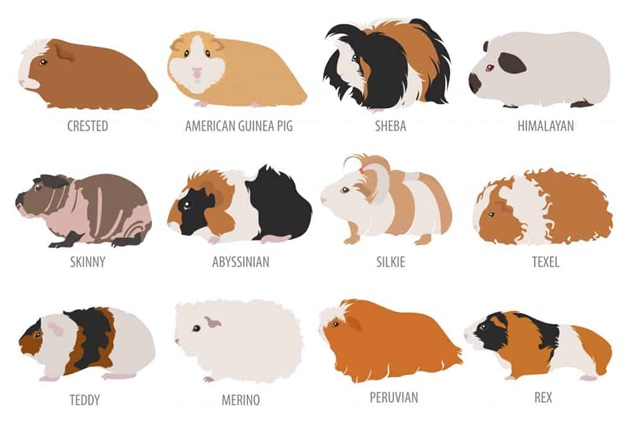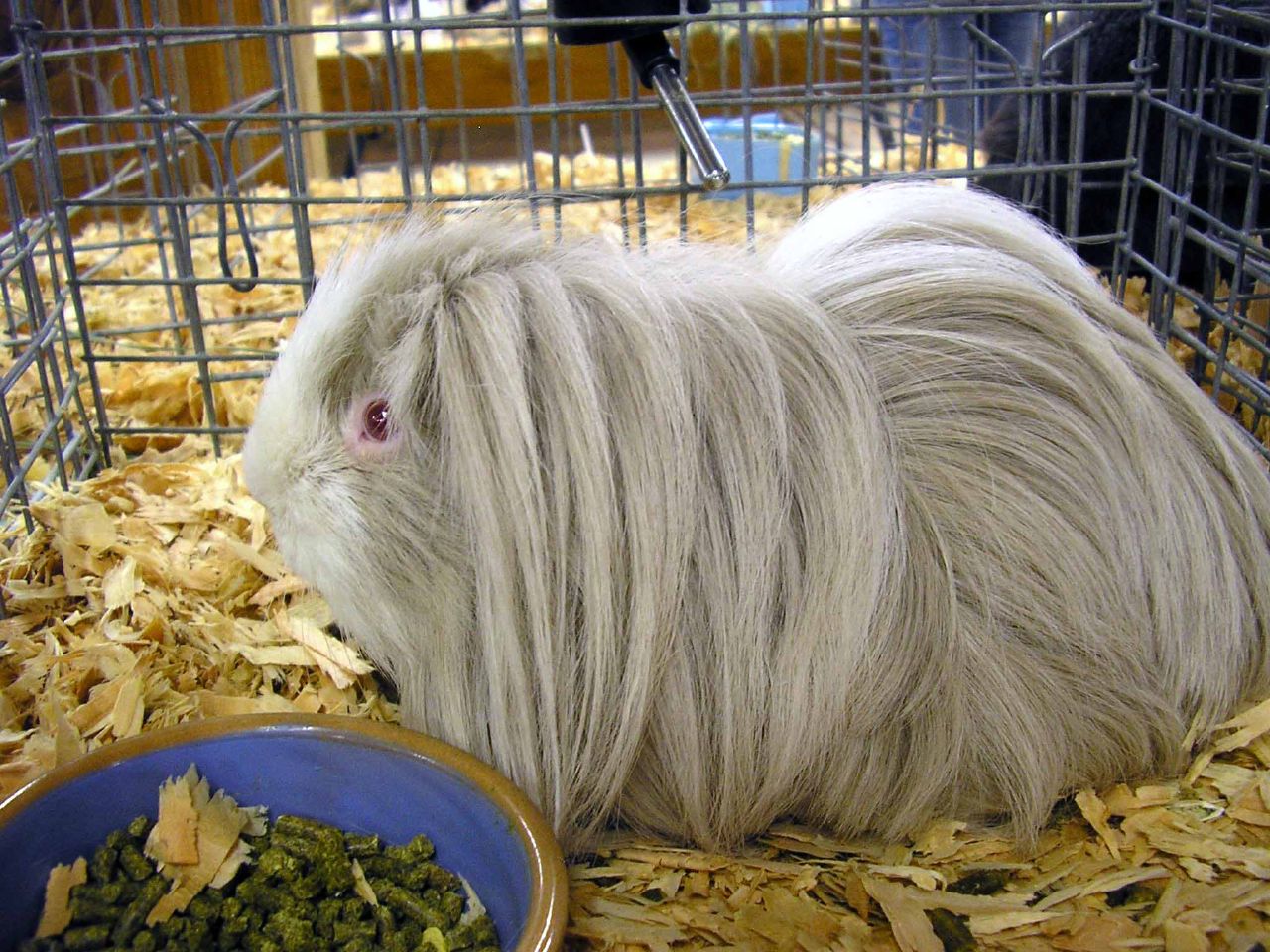Common breeds of guinea pigs include American, Abyssinian, Peruvian, and Skinny Pig. These breeds vary in appearance and characteristics, making them popular pets for many individuals.
Guinea pigs are known for their friendly demeanor, making them ideal companions for both adults and children. Whether you prefer the short, smooth coat of the American guinea pig or the long, flowing hair of the Peruvian, there is a breed to suit every preference.
Guinea pigs are social animals that thrive in pairs or small groups, so consider adopting more than one to keep them happy and healthy. Understanding the different breeds can help you choose the perfect guinea pig for your family.
Contents
- Introduction To Guinea Pig Breeds
- American Guinea Pig
- Abyssinian Guinea Pig
- Peruvian Guinea Pig
- Silkie Guinea Pig
- Teddy Guinea Pig
- Choosing The Right Breed
- Health And Wellbeing Of Guinea Pigs
- Social Life And Companionship
- Common Misconceptions About Guinea Pig Breeds
- Adopting A Guinea Pig
- Frequently Asked Questions
- Conclusion
Introduction To Guinea Pig Breeds
Guinea pigs are delightful and popular pets that come in a variety of breeds, each with its own unique characteristics. Understanding the different breeds of guinea pigs can help pet owners choose the best fit for their lifestyle and preferences. In this section, we will explore the introduction to guinea pig breeds, the popularity of guinea pigs as pets, and the importance of understanding breeds.
Popularity Of Guinea Pigs As Pets
Guinea pigs are incredibly popular pets, cherished for their friendly nature and low maintenance requirements. They are ideal for families and individuals alike, making them a beloved choice for pet enthusiasts worldwide.
Importance Of Understanding Breeds
Understanding the various breeds of guinea pigs is essential for pet owners. Different breeds have distinct characteristics, such as fur length, color patterns, and personality traits. This knowledge allows individuals to select a guinea pig that aligns with their preferences and living situation, ensuring a harmonious and fulfilling pet ownership experience.

Credit: guineapigs.fandom.com
American Guinea Pig
The American Guinea Pig, also known as the American cavy, is one of the most popular breeds of guinea pigs. They are known for their friendly and gentle nature, making them great pets for families and individuals alike. American Guinea Pigs have a short, smooth coat and come in a variety of colors, including white, black, and tricolor.
Characteristics Of The American Breed
American Guinea Pigs are characterized by their smooth, short coat and a rounded, compact body. They typically weigh between 1.5 to 2.5 pounds and have a lifespan of 5 to 7 years. These guinea pigs are known for their gentle temperament and are often recommended for first-time pet owners.
Ideal Environments For American Guinea Pigs
Creating a suitable environment for American Guinea Pigs is essential for their well-being. They thrive in spacious cages with solid flooring to protect their sensitive feet. Providing a variety of chew toys, tunnels, and hiding spots can help keep these guinea pigs mentally stimulated and physically active.
Abyssinian Guinea Pig
Abyssinian Guinea Pigs are adored for their unique appearance, characterized by swirls of hair that form rosettes across their body. These delightful creatures have a spirited and inquisitive nature, making them a popular choice for guinea pig enthusiasts.
Identifying Abyssinian Features
The most distinctive feature of an Abyssinian Guinea Pig is its rosettes, which are formed by hair growing in different directions from a central whorl. These rosettes give the Abyssinian a distinct and charming appearance, setting them apart from other guinea pig breeds.
Caring For Abyssinian Fur
Due to their unique fur type, Abyssinian Guinea Pigs require regular grooming to prevent matting and tangling. Daily brushing with a soft bristle brush is essential to maintain the health and appearance of their coat. Additionally, providing a diet rich in vitamin C is crucial for the overall well-being of Abyssinian Guinea Pigs.

Credit: en.wikipedia.org
Peruvian Guinea Pig
The Peruvian guinea pig is a long-haired breed known for its flowing locks and elegant appearance. This breed is one of the most popular and recognizable among the common breeds of guinea pigs, admired for its gentle nature and affectionate personality.
Peruvian Guinea Pig is one of the most popular breeds of guinea pigs around the world. They are known for their long, silky hair that grows in a distinctive pattern. In this section, we will discuss the Long Hair Distinction and Grooming and Maintenance Tips for Peruvian Guinea Pigs.Long Hair Distinction
Peruvian Guinea Pigs are known for their unique long hair that can grow up to 20 inches in length. Their hair grows continuously, and if not groomed properly, it can become matted and tangled. The long hair of Peruvian Guinea Pigs starts from their forehead and flows backward to their hindquarters, forming a part down their back. They have no rosettes on their coat and are known for their smooth, flowing hair that requires a lot of care and attention.Grooming And Maintenance Tips
Grooming and Maintenance is crucial for Peruvian Guinea Pigs to keep their long hair in good condition. Here are some tips to help you keep your Peruvian Guinea Pig’s hair healthy and tangle-free:- Brush your Peruvian Guinea Pig’s hair daily with a soft-bristled brush to prevent tangles and matting.
- Use a fine-toothed comb to remove any tangles or knots gently.
- Trim the hair around the feet and anus regularly to avoid fecal matter getting stuck in the hair.
- Bathe your Peruvian Guinea Pig once every three months using a mild shampoo to keep their hair clean and healthy.
- Always dry their hair completely after a bath to prevent any bacterial or fungal infections.
- Provide a balanced diet that is rich in Vitamin C and fiber to maintain the overall health of your Peruvian Guinea Pig’s coat.
Silkie Guinea Pig
The Silkie Guinea Pig is known for its unique long, silky coat that sets it apart from other breeds.
Silkie’s Unique Coat
The Silkie Guinea Pig has a distinctive long and soft coat that requires regular grooming.
Special Attention For Silkies
- Regular grooming to prevent matting and maintain the coat’s health.
- Provide a clean environment to keep their coat free from dirt and debris.
- Monitor for potential health issues related to their coat, such as skin infections.
- Ensure a proper diet to support healthy coat growth and overall well-being.

Credit: www.youtube.com
Teddy Guinea Pig
The Teddy Guinea Pig is known for its adorable appearance and unique characteristics. These fluffy creatures have a distinct plush coat that sets them apart from other guinea pig breeds.
Teddy’s Plush Coat
The Teddy Guinea Pig’s coat is soft, dense, and resembles a teddy bear’s fur, hence the name. This breed comes in various colors, including white, black, and tricolor combinations.
Health Considerations For Teddies
- Regular grooming is essential to prevent matting of the Teddy Guinea Pig’s dense coat.
- Ensure a balanced diet rich in vitamin C to maintain their overall health.
- Monitor their weight to prevent obesity, a common issue in guinea pigs.
Choosing The Right Breed
When choosing the right breed of guinea pig, it’s important to consider the common breeds available. Popular options include the American, Abyssinian, and Peruvian guinea pigs, each with their own unique characteristics and care requirements. Understanding the traits of these common breeds can help you make an informed decision when adding a guinea pig to your family.
Guinea pigs are social, affectionate, and adorable pets that come in a variety of breeds. Each breed has its unique characteristics, personality, and requirements. Therefore, it’s essential to choose the right breed that matches your lifestyle and preferences. In this article, we’ll discuss the factors to consider when choosing a guinea pig breed and how to match it to your lifestyle.Factors To Consider
Before choosing a guinea pig breed, you need to consider several factors, including:| Factor | Description |
|---|---|
| Size | Guinea pigs come in different sizes, from small to large. Consider the size of your home and the space you can provide for your pet. |
| Coat type | Guinea pigs have three main coat types: short hair, long hair, and curly hair. Each type requires a different level of grooming and maintenance. |
| Temperament | Some guinea pig breeds are more active and outgoing, while others are shy and calm. Consider your personality and lifestyle when choosing a breed. |
| Life span | Guinea pigs have a lifespan of 5 to 8 years. Consider the long-term commitment of owning a guinea pig. |
Matching A Breed To Your Lifestyle
Once you’ve considered the factors above, you can match a guinea pig breed to your lifestyle. Here are some examples:- Short-haired breeds: If you have a busy lifestyle and don’t have much time for grooming, consider a short-haired breed like the American or Abyssinian guinea pig.
- Long-haired breeds: If you enjoy grooming and have time for daily maintenance, consider a long-haired breed like the Peruvian or Silkie guinea pig.
- Active breeds: If you have an active lifestyle and enjoy playing with your pet, consider a breed like the Teddy or Texel guinea pig.
- Calm breeds: If you prefer a more laid-back pet, consider a breed like the Coronet or Himalayan guinea pig.
Health And Wellbeing Of Guinea Pigs
Guinea pigs come in various breeds, each with its unique characteristics. Some common breeds include the American, Abyssinian, and Peruvian guinea pigs, each with distinct fur patterns and textures. Understanding the different breeds can help in providing tailored care to ensure the health and wellbeing of these small pets.
Guinea pigs are adorable pets that require regular attention and care to maintain their health and wellbeing. As a pet owner, it is your responsibility to ensure that your furry friend is healthy and happy. In this blog post, we will discuss the common breeds of guinea pigs and focus on the essential aspects of their health and wellbeing. Here are some crucial factors that you should consider to keep your guinea pig healthy and happy:Regular Veterinary Care
One of the most critical aspects of keeping your guinea pig healthy is regular veterinary care. You should take your guinea pig to a veterinarian who specializes in small animals at least once a year. A veterinarian will examine your guinea pig’s overall health, check for any signs of illness, and provide you with the necessary advice to maintain their health. A regular checkup can help detect any underlying health issues that may require immediate attention.Diet And Nutrition Basics
A guinea pig’s diet plays a crucial role in maintaining their health and wellbeing. You should provide them with a balanced and nutritious diet that includes hay, fresh vegetables, and fruits. Guinea pigs require a high-fiber diet to maintain healthy digestion. You should avoid feeding them with foods that are high in sugar or fat, as they can cause obesity and other health problems. Consult with your veterinarian about your guinea pig’s diet and nutrition to ensure that they are getting the right nutrients.Here are some essential diet and nutrition basics that you should consider:- Hay is an essential part of a guinea pig’s diet. It helps maintain healthy digestion and prevents dental problems.
- Provide fresh vegetables and fruits daily to ensure that your guinea pig gets the necessary vitamins and minerals.
- Avoid feeding your guinea pig with foods that are high in sugar and fat, such as chocolate, bread, and dairy products.
- Make sure your guinea pig has access to clean and fresh water at all times.
Social Life And Companionship
Guinea pigs are social creatures that thrive on companionship.
The Importance Of Social Interaction
Guinea pigs require social interaction for their well-being.
Bonding with their human and fellow guinea pigs is vital.
Loneliness can lead to stress and health issues.
Introducing New Guinea Pigs
Introduce new guinea pigs gradually to prevent conflicts.
Observe their interactions to ensure they get along.
Providing a large enough living space is crucial for harmony.
Common Misconceptions About Guinea Pig Breeds
Discover the truth behind common misconceptions about guinea pig breeds. Learn about the various breeds and unravel the myths surrounding their characteristics and care needs.
Debunking Myths
Guinea pig breeds are often surrounded by misconceptions that can lead to misunderstandings.
Let’s debunk some common myths about guinea pig breeds:
- Myth: All guinea pigs are the same breed.
- Myth: The breed determines a guinea pig’s personality.
- Myth: Purebred guinea pigs are always healthier.
Understanding Breed-specific Behaviors
Guinea pig breeds exhibit unique behaviors based on their breed characteristics.
Understanding breed-specific behaviors can help in providing appropriate care:
- Abyssinian: Known for their energetic and playful nature.
- Peruvian: Recognized for their long, flowing hair that requires grooming.
- Texel: Have curly fur that needs regular maintenance.
Adopting A Guinea Pig
Adopting a Guinea Pig offers a variety of options when it comes to common breeds. From the popular Abyssinian to the charming Teddy, each breed has its own unique characteristics and personality traits, making them a perfect addition to any family.
Guinea pigs are social and friendly animals that make great pets for families or individuals. Before adopting a guinea pig, you need to consider the breed, where to adopt from, and how to choose a responsible breeder. In this post, we will discuss common breeds of guinea pigs and the different options for adopting them.Choosing A Responsible Breeder
If you decide to adopt a guinea pig from a breeder, it’s essential to choose a responsible one. A responsible breeder will ensure that the guinea pig is healthy, well-cared for, and has a good temperament. They will also be knowledgeable about the breed and provide you with the necessary information and support to care for your new pet.When choosing a breeder, you should consider the following:- Check the breeder’s credentials and reputation
- Visit the breeder’s facility and check the living conditions of the guinea pigs
- Ask the breeder about the guinea pig’s health history and temperament
- Ensure that the guinea pig is at least six weeks old before adoption
Adoption From Shelters
Adopting a guinea pig from a shelter is another option. Shelters often have guinea pigs that need homes, and adoption fees are usually lower than buying from a breeder. When adopting from a shelter, you can also be sure that the guinea pig has been well-cared for and checked by a veterinarian.Here are some things to consider when adopting from a shelter:- Check the shelter’s reputation and reviews
- Visit the shelter and observe the guinea pigs’ living conditions
- Ask the shelter staff about the guinea pig’s health and temperament
- Ensure that the guinea pig is at least six weeks old before adoption
Frequently Asked Questions
What Are The Most Common Breeds Of Guinea Pigs?
The most common breeds of guinea pigs include the American, Abyssinian, Peruvian, and Teddy. Each breed has its own unique characteristics and appearance, making them popular choices among guinea pig enthusiasts.
How Do I Identify The American Breed Of Guinea Pig?
The American breed of guinea pig is recognized by its short, smooth coat that lies flat against its body. They typically have a round head and a stocky build. This breed is known for its friendly and docile nature, making it a popular choice for families.
What Is Special About The Abyssinian Breed Of Guinea Pig?
The Abyssinian breed of guinea pig is known for its unique coat, which consists of rosettes or swirls of hair all over its body. This breed requires regular grooming to keep its coat in good condition. Abyssinians are active and social pets that love interaction with their owners.
How Can I Differentiate The Peruvian Breed From Other Guinea Pig Breeds?
The Peruvian breed of guinea pig stands out with its long, flowing hair that can grow up to 20 inches in length. This breed requires regular grooming to prevent tangles and keep its coat healthy. Peruvians are known for their gentle and calm temperament, making them great companions.
Conclusion
Learning about the common breeds of guinea pigs can help you make an informed decision when choosing a furry companion. Whether you prefer the adorable Abyssinian, the long-haired Peruvian, or the sociable American guinea pig, each breed has its own unique characteristics and care requirements.
By understanding their traits and needs, you can ensure a happy and healthy life for your guinea pig. So, take the time to research and consider which breed is the best fit for you and your family. Happy guinea pig hunting!



